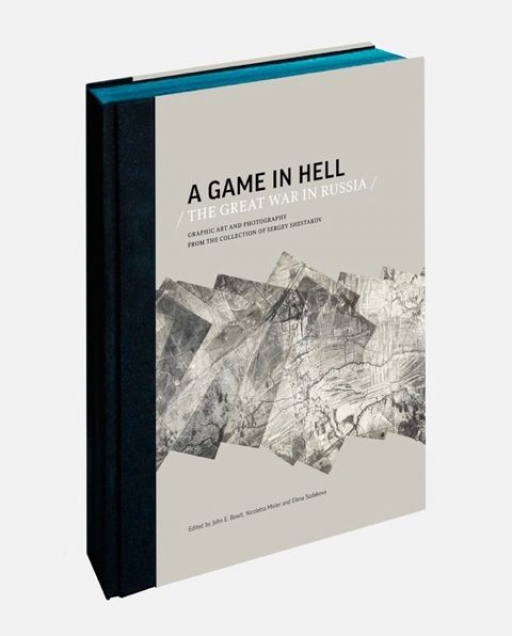Publisher’s Description:
This bi-lingual publication presents a remarkable display of documentary and artistic materials dating from Russia’s engagement on the Eastern and Southern Fronts. The title references a volume of Futurist poetry and thus identifies the book strongly with modernist artistic trends in Russia. The objects illustrated and discussed nevertheless range from lubki (popular prints) to posters, personal photograph albums and books by avant-garde artists and writers, and thus relate to the broad currents in art and society converging on this unprecedented crisis for Russia and her allies.
Centenary News Review:
Review by: Peter Alhadeff, Centenary News Deputy Editor.
A Game in Hell is a stunning visual record of how Imperial Russia saw the First World War. Many of the pictures and photographs are published for the first time, Russia’s role in the conflict having been almost banished from history after the Bolshevik revolution in 1917.
The images range from crude caricatures of the Austrian, German and Turkish enemy to personal photos of soldiers at the front, and sophisticated illustrations of battle. Particularly remarkable are the photographs of Russia’s pioneering airmen. Like so much in this book, they are a revelation, and probably not just to Western readers.
Most of the prints, posters and cartoons belong to a private Moscow collector, Sergey Shestakov. They formed the core of an exhibition at the Gallery of Russian Arts and Design (GRAD) in London in the autumn of 2014.

(Photo: courtesy of Tim Roberts/GRAD)
In his foreword to A Game in Hell, Shestakov remarks on a ‘strange sense of absent history between the demise of Imperial Russia and the emergence of the Soviet Union.’
“People of my generation had no idea of the real events preceding the Revolution, of the people and heroes who were making the history of my country at the time,” he says.
“We knew practically nothing about the First World War (the Great War) and the role of Russia in that global history.”
The Nazi invasion of the Soviet Union in 1941 forced a rethink of Tsarist Russia’s generals in the Patriotic War against Napoleon. But those who fought who fought Germany from 1914-17 enjoyed no such rehabilitation.
As historian Sergey Volkov, one of the contributors to A Game in Hell, notes: “several decades of Bolshevik propaganda managed to turn the conflict in the collective mind into a shameful ‘imperial’ war.”
Awakening
The Centenary has awakened interest in Russia, although much remains unfamiliar. A Game in Hell gives a flavour of the conflict across vast tracts of Eastern Europe, as seen from St. Petersburg and Moscow.
Many of prints and cartoons make vivid use of colour, as befits the efficient propaganda machine developed by Tsarist Russia to bolster support for the war. It’s no surprise that Kaiser Wilhelm, lampooned as a moustachioed villain, comes off badly against heroic portraits of the Russian commander-in-chief, Grand Duke Nicholas, and War Minister Vladimir Sukhomlinov.
But things aren’t always as they appear of course. The noble looking Sukhomlinov himself was sacked in 1915 in a row over military defeats on the Eastern Front and arrested the following year.
Tsar Nicholas II, and Alexander Kerensky, the man who briefly took charge as leader of the provisional government in 1917, both make appearances in a rare album of photos telling the story of Russia’s early aviators. The crash scenes are a reminder that mechanical failures and inexperience could be as much of a threat as the enemy.
Meanwhile the Tsar, so often remembered as a weak and vacillating figure, emerges with some credit from a visit to his troops in what is now southwestern Ukraine. He pressed on with the inspection, despite an attack by two Austrian fighter planes.
Historians say the Centenary should be used as an opportunity to rekindle interest in the First World War beyond the mud and trenches of the Western Front. A Game in Hell is a treasure trove of images reminding us that Russia was among the key players.
‘A Game in Hell’ is available directly, price £35, from the Gallery of Russian Arts and Design 3-4a Little Portland Street London W1W 7JB. GRAD is a not-for-profit exhibition space which aims to present Russian works of art, primarily from the 20th century, which have not been seen in the UK before.
What do you think about this book or review? Please add a comment below.
Images courtesy of Tim Roberts/GRAD
Posted by: Peter Alhadeff, Centenary News
